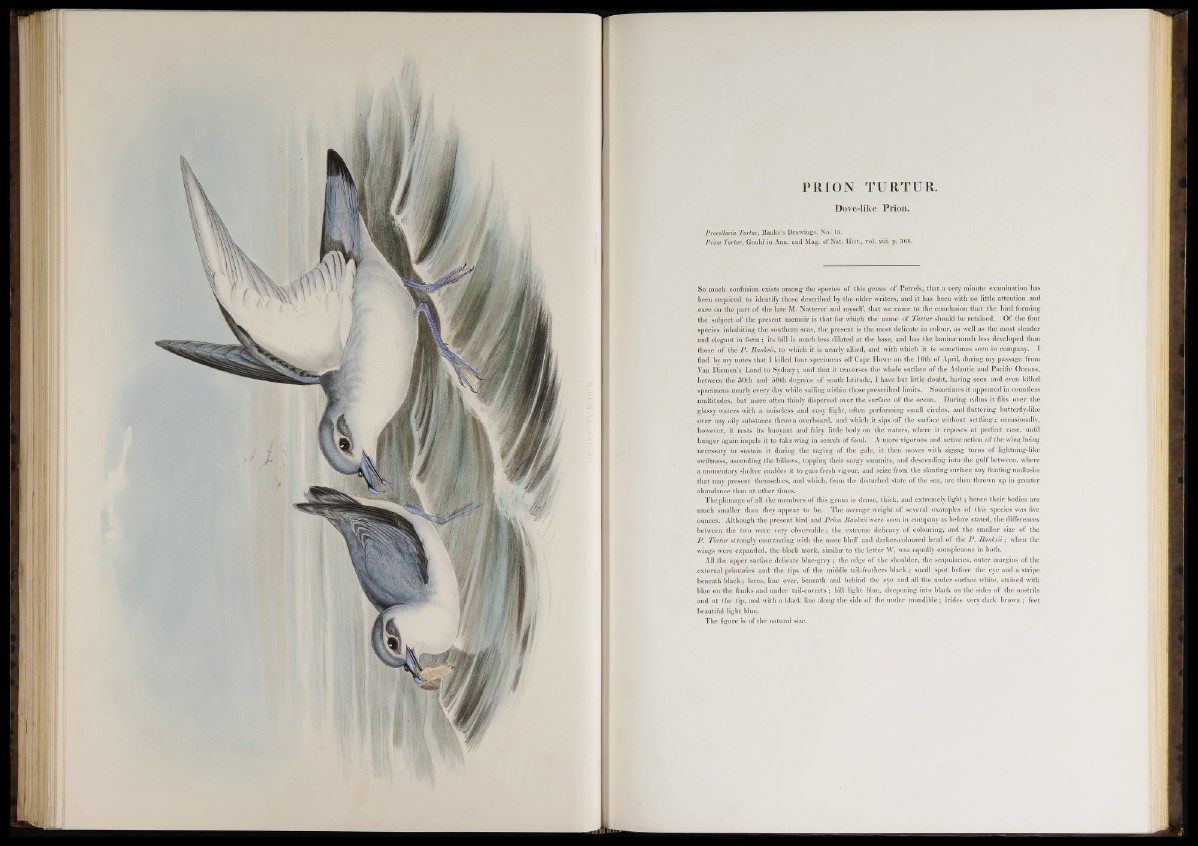
PRION TURTUR.
Dove-like Prion.
Procellaria Turtur, Banks’s Drawings, No. 15.
Prion Turtur, Gould in Ann. and Mag. o f Na t. Hist., vol. xiii. p. 366.
So much confusion exists among the species o f this genus o f Petrels, that a very minute examination has
been required to identify those described by the older writers, and it has been with no little attention and
care on the part of the late M. Natterer and myself, that we came to the conclusion that the bird forming
the subject of the present memoir is that for which the name of Turtur should be retained. Of the four
species inhabiting the southern seas, the present is the most delicate in colour, as well as the most slender
and elegant in form; its bill is much less dilated at the base, and has the laminae much less developed than
those of the P . Banksii, to which it is nearly allied, and with which it is sometimes seen in company. I
find by my notes that I killed four specimens off Cape Howe on the 16th of April, during my passage from
Van Diemen’s Land to Sydney; and that it traverses the whole surface of the Atlantic and Pacific Oceans,
between the 30th and 50th degrees of south latitude, I have but little doubt, having seen and even killed
specimens nearly every day while sailing within those prescribed limits. Sometimes it appeared in countless
multitudes, but more often thinly dispersed over the surface of the ocean. During calms it flits over the
glassy waters with a noiseless and easy flight, often performing small circles, and fluttering butterfly-like
over any oily substance thrown overboard, and which it sips off the surface without settling; occasionally,
however, it rests its buoyant and fairy little body on the waters, where it reposes at perfect ease, until
hunger again impels it to take wing in search of food. A more vigorous and active action of the wing being
necessary to sustain it during the raging of the gale, it then moves with zigzag turns o f lightning-like
swiftness, ascending the billows, topping their surgy summits, and descending into the gulf between, where
a momentary shelter enables it to gain fresh vigour, and seize from the slanting surface any floating mollusks
that may present themselves, and which, from the disturbed state of the sea, are then thrown up in greater
abundance than at other times.
The plumage o f all the members of this genus is dense, thick, and extremely ligh t; hence their bodies are
much smaller than they appear to be. The average weight of several examples of this species was five
ounces. Although the present bird and Prion Banksii were seen in company as before stated, the differences
between the two were very observable; the extreme delicacy of colouring, and the smaller size o f the
P . Turtur strongly contrasting with the more bluff and darker-coloured head o f the P . Ba n ksii; when the
wings were-expanded, the black mark, similar to the letter W, was equally conspicuous in both.
All the upper surface delicate blue-grey; the edge of the shoulder, the scapularies, outer margins of the
external primaries and the tips of the middle tail-feathers black; small spot before the eye and a stripe
beneath black; lores, line over, beneath and behind the eye and all the under surface white, stained with
blue on the flanks and under tail-coverts ; bill light blue, deepening into black on the sides of the nostrils
and at the tip, and with a black line along the side o f the under mandible; irides very dark brown ; feet
beautiful light blue.
The figure is of the.natural size.